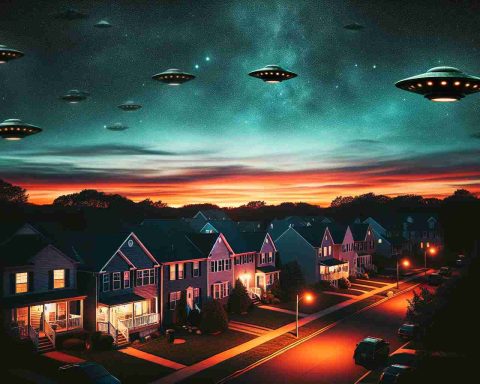Experts Weigh In on Extraterrestrial Life
Could we finally be on the verge of discovering alien life? Recent studies reveal surprising insights into what scientists truly believe about the existence of extraterrestrial beings. A recent paper published in Nature Astronomy dives deep into the opinions of experts in astrobiology and related fields.
Between February and June of 2024, researchers conducted four comprehensive surveys among more than 1,000 scientists, including 521 astrobiologists. The findings are remarkable: over 86% of astrobiologists expressed agreement that basic extraterrestrial life likely exists somewhere in the universe, with an astonishing 97.8% consensus when neutral responses were excluded.
The report highlights that even non-astrobiologists share similar views, with an 88.4% agreement rate. While support for the existence of more complex or intelligent life was lower—67.4% and 58.2%, respectively—disagreement remained minimal, especially regarding intelligent aliens.
Interestingly, while some scientists remained neutral to avoid speculation, the overwhelming consensus suggests that they recognize indirect evidence of life’s potential, including numerous habitable environments identified both within our solar system and beyond.
As we expand our understanding of the cosmos and the conditions necessary for life, it appears that both optimism and caution can coexist in the scientific community, paving the way for future discoveries that may finally answer the question: are we truly alone in the universe?
The Broader Implications of Extraterrestrial Life Discoveries
The ongoing exploration for extraterrestrial life not only challenges our understanding of biology but could also have profound societal and cultural consequences. The prospect of discovering alien life would likely compel humanity to reexamine its place in the universe. This shift in perspective could foster a sense of shared identity among people, transcending national boundaries and cultural differences. If we were to confirm that life exists elsewhere, it might catalyze global collaboration in scientific endeavors, encouraging nations to unite in the pursuit of knowledge rather than compete.
Furthermore, the discovery of intelligent extraterrestrial civilizations could revolutionize the global economy. Advancements in space technology driven by this search may lead to innovations applicable on Earth, including new materials and sustainable practices, ultimately promoting economic growth. Nations are already investing in space exploration, and increased interest could direct more resources toward advancements in science and technology sectors.
Yet, we must also ponder the environmental implications of such discoveries. As humanity reaches out to space, the prospect of colonizing other planets raises questions about conservation and environmental stewardship beyond Earth. The ethical considerations behind such actions could reshape our responsibilities toward our own planet.
In essence, the quest for alien life could serve as a catalyst for profound changes across various dimensions of society, pushing humanity toward a future where both the mysteries of the cosmos and the welfare of our planet intertwine critically.
Are We Alone? Experts Predict the Future of Extraterrestrial Life Discovery
The Quest for Extraterrestrial Life: Insights and Predictions
The intriguing question of whether we are alone in the universe has captivated scientists and the public alike for decades. With recent studies shedding light on expert opinions in astrobiology, we are closer than ever to understanding the potential for extraterrestrial life. A significant study published in Nature Astronomy surveyed over 1,000 scientists on their beliefs and findings concerning alien life, revealing optimistic insights and raising further questions about what lies beyond our planet.
# Key Findings from the Survey
1. High Consensus on Basic Life: A striking 86% of astrobiologists support the idea that simple extraterrestrial life forms likely exist somewhere in the universe. This figure rises to 97.8% when excluding neutral responses, indicating a strong belief within the scientific community.
2. Broader Support Across Disciplines: Agreement extends beyond astrobiologists, with 88.4% of scientists from diverse fields acknowledging the possibility of basic extraterrestrial life, showing a wide-ranging consensus in the scientific community.
3. Interest in Intelligent Life: While the notion of complex or intelligent extraterrestrial beings garners less enthusiasm—67.4% for complex life and only 58.2% for intelligent life—the minimal disagreement suggests that, while not fully supportive, many scientists remain open to the possibilities.
# Trends in Astrobiology Research
As technologies advance and exploratory missions enhance our understanding of space, researchers are focused on several key areas:
– Search for Habitable Environments: Ongoing research identifies numerous potentially habitable locations within our solar system, including moons like Europa and Enceladus, as well as exoplanets in the ‘Goldilocks Zone’ of distant star systems.
– Astrobiological Innovations: Technological innovations, such as improved spectrometers and advanced imaging techniques, are crucial in the search for biosignatures—indicators that point toward life.
– Interdisciplinary Collaboration: The integration of knowledge from various scientific disciplines is strengthening the search efforts. This collaboration includes geologists, chemists, and planetary scientists working alongside astrobiologists to explore life’s potential in extreme environments.
# Limitations and Challenges
Despite the growing consensus, several challenges remain:
– Detection Technology: Current instruments and methodologies may not be sufficient to definitively detect extraterrestrial life. As a result, many scientists advocate for investing in next-generation technologies that can enhance detection capabilities.
– Interpretation of Data: Interpreting signals or biosignatures remains complex. There’s the risk of misinterpretation leading to false positives, distinguishing actual signs of life from abiotic processes.
# Conclusion: A Bright Future for Astrobiological Discoveries
The overwhelming agreement among scientists underscores the belief in the possibility of extraterrestrial life, propelling the field of astrobiology forward. With ongoing research, technological advancements, and a growing understanding of habitability, the search for life beyond Earth is positioned to flourish in the coming years.
As we brace ourselves for potential discoveries that could alter our perception of life in the universe, one thing remains clear: the journey to understand our place in the cosmos is only just beginning.
For more extensive insights and studies related to this topic, visit the Nature website.




















